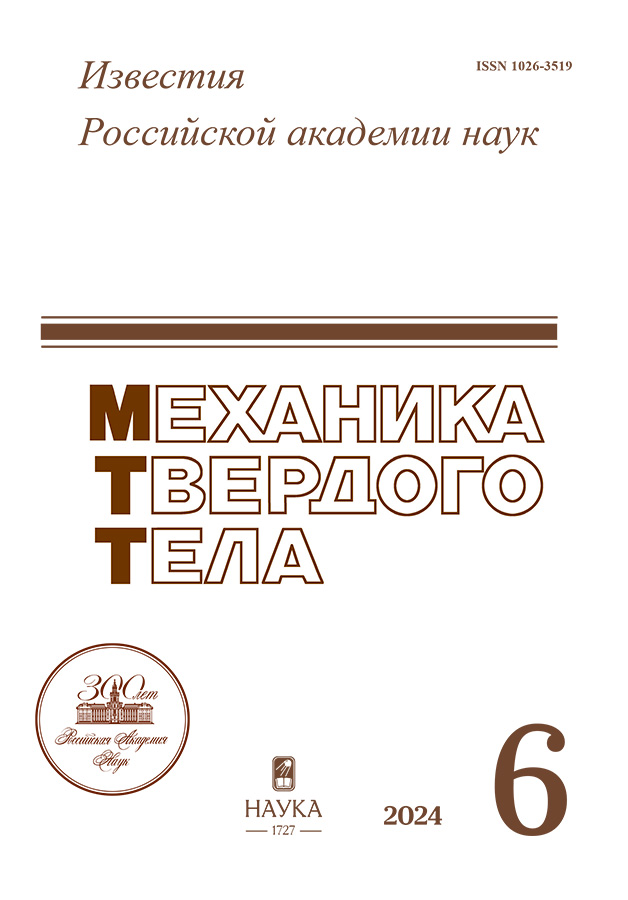Type-II thermoelasticity of linear anisotropic micropolar media
- Autores: Radayev Y.N.1
-
Afiliações:
- Institute for Problems in Mechanics of RAS, Leading Researcher
- Edição: Nº 6 (2024)
- Páginas: 205-217
- Seção: Articles
- URL: https://hum-ecol.ru/1026-3519/article/view/682279
- DOI: https://doi.org/10.31857/S1026351924060126
- EDN: https://elibrary.ru/TXGLQL
- ID: 682279
Citar
Texto integral
Resumo
In this paper, the mechanics of micropolar elastic solids is extendded to more general thermoelastic media in order to take account of the effect of temperature on their states and mechanical behavior. Since a thermoelastic micropolar medium conducts heat, it is required to include one or another mechanism of thermal conductivity in the basic equations of micropolar thermoelasticity. A model of thermoelastic micropolar medium CGNII is developed on ground of the wave principle of heat transfer (i.e., thermal conductivity of the second type known from previous discussions by Green and Naghdi), characterized by zero internal entropy production. All the basic equations of the theory presented in this study are derived from the conventional equations of balance of continuum mechanics and the fundamental thermodynamic inequality. Constitutive equations for a linear anisotropic thermoelastic micropolar medium (CGNII) are obtained by using a quadratic energy form for the Helmholtz free energy. Special attention is paid to hemitropic micropolar medium, when the components of one of the fourth rank constitutive pseudotensors demonstrate sensitivity to mirror reflections of three-dimensional space. A closed system of coupled differential equations is given in terms of translational displacements, microrotations and temperature displacement. It is important since can be used in formulations of applied problems of thermomechanics regarding to the wave heat transfer mechanism in micropolar elastic media.
Texto integral
Sobre autores
Yu. Radayev
Institute for Problems in Mechanics of RAS, Leading Researcher
Autor responsável pela correspondência
Email: radayev@ipmnet.ru
Rússia, Moscow
Bibliografia
- Cosserat E., Cosserat F. Théorie des corps déformables. Herman et Fils, Paris, 1909. vi+226 pp.
- Radayev Y.N. Tensors with constant components in the constitutive equations of hemitropic micropolar solids // Mech. of Solids. 2023. V. 58. N. 5. P. 1517–1527. https://doi.org/10.3103/S0025654423700206
- Nowacki W. Theory of Asymmetric Elasticity. Pergamon Press, Oxford, New York, Toronto, Sydney, Paris, Frankfurt, 1986. viii+383 pp.
- Green A.E, Naghdi P.M. Thermoelasticity without energy dissipation // J. Elasticity. 1993. V. 31. P. 189–208.
- Radayev Y.N. The Lagrange multipliers method in covariant formulations of micropolar continuum mechanics theories. Journal of Samara State Technical University. Ser. Physics and Mathematics. 2018. V. 22. N. 3. P. 504–517 (in Russian). https://doi.org/10.14498/vsgtu1635
- Jeffreys H. Cartesian Tensors. Cambridge, Cambridge University Press, 1969. VII+93 pp.
- Radayev Y.N. Two-Point Rotations in Geometry of Finite Deformations. In: Altenbach H., Mkhitaryan S.M., Hakobyan V., Sahakyan A.V. (eds) Solid Mechanics. Theory of Elasticity and Creep. Advanced Structured Materials. V. 185. Springer, Cham, 2023. P. 275–283.
Arquivos suplementares










